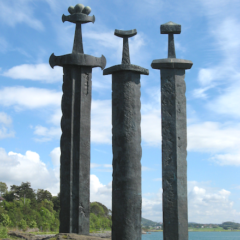This is a brief summary of the history of the Vikings, of those efficient seafarers, robbers, settlers, traders and conquerors, whose influence spread across Europe in the Middle Ages.
(In the descriptions below, I refer to „Norwegians“, „Danes“ and „Swedes.“ This means in any case mainly Norwegians, Danes and Swedes. In most Viking activities, other nations were also involved, but as minorities; even „Germans“ – from today’s Schleswig Holstein).
In general one can say that:
The Norwegians sailed from their native lands in south-westerly or westerly directions and „operated“ mainly in the North Atlantic. First, they invaded and robbed monasteries and coastal settlements in Scotland, the Hebrides, the Isle of Man, and Ireland. From the end of the eighth century onwards, they settled the Orkneys and the Shetlands, and later founded the „Norse Kingdom of Man and the Isles“. They quickly integrated with the early Christian population of Ireland and founded the southern trading cities of Cork, Waterford and Wexford as well as Dublin („Dub-linh“ = Old Norse/Old Irish = „Black pond“). Later, they discovered and settled the Faroe Islands and Iceland (from 870 on) and even dared to voyage out as far as Greenland, where they ran Norwegian colonies along the west coast for more than 400 years. From the Greenland settlements, they continued westwards across the Davis Strait to the north of Canada, or more precisely, the Island of Newfoundland in the Gulf of St. Lawrence (about A.D. 1000). The latter having been proved by the discovery, excavation and the scientific evidence unearthed at the „L’Anse aux Meadows“ settlement. Any further journeys into the North American continent are lost in the darkness of history, if they took place at all.
The Danes robbed and plundered not only across the North Sea, but also in the seas all around Europe. From 795, they invaded monasteries and coastal settlements of Franconia and Friesland and sailed far inland up the great rivers. For example, they laid siege to Paris several times, destroyed Hamburg („Hammaburg“), and reached Cologne and Trier (882). They also raided lands around the Gulf of Biscay and in the Mediterranean and invaded the settlements around the mouth of the Tagus. With about 100 ships, they sailed up the Guadalquivir and plundered Seville (844) in a Viking raid. They were soon driven out again by warriors of the then Moorish kingdom in Spain. In the year 859 they plundered once more in the Mediterranean, including raids on Menorca and Mallorca.
For later historians, however much more important (today one would say „sustainably“) was their presence in Anglo-Saxon England, which they had been attacking from even earlier (787 onwards). In the year 865 however, they came with the intention of staying for good. The sons of Ragnar landed in East Anglia with several thousand warriors on 300 ships – the „Great Danish Army“ – had arrived. Although the the number of warriors and ships is probably exaggerated, it was a very effective campaign indeed. With horses requisitioned from the coastal inhabitants and access to the old Roman roads, they advanced into the hinterland and ended up in York in the autumn of 866. The Danelaw, the area on English soil under Danish rule was established. From then on up to the final settlement at the end of 1066 by the Norman conquest, England was divided into an Anglo-Saxon southern part and a Danish northern part, even if the boundaries were never definitely settled during these 200 years.
„Final phase“ of the Vikings expansion from today’s Denmark and Norway was, however the acquisition of habitat – the definite process of colonisation of conquered lands!
The Swedish Vikings, also known as Varangians (from “Varangian Guard” = the famous guard of the Byzantine emperor), had from the very beginning their focus on trade. They crossed the Ladoga Lake and travelled up the Volkhov to the Waldai heights, where the Dniepr, as well as the Volga river, emerge. Over the course of several generations, they travelled across these Russian rivers to Constantinople, which they called Miklagård. On the way, they founded (or were at least involved in founding) some famous cities like Staraja Ladoga (Aldeigjuborg), Novgorod and Kiev. Thus they opened trade routes across vast areas of Russia, the Near and Far East and served as experienced bodyguards to the Byzantine kings (and queens) in Constantinople. One of them was the Varangian-Guard commander even (Harald III „the hard“ of Norway). This mercenary activity led them later to be called Varaigns also. Although the information on the Varaigns is much more sparse (especially as regards documents), there are numerous clues, e.g. the finds of immense gold and silver treasures on Gotland!
The Normans were a special case. “Norman” and „Viking“ are however not synonyms, as often implied —>see next page
